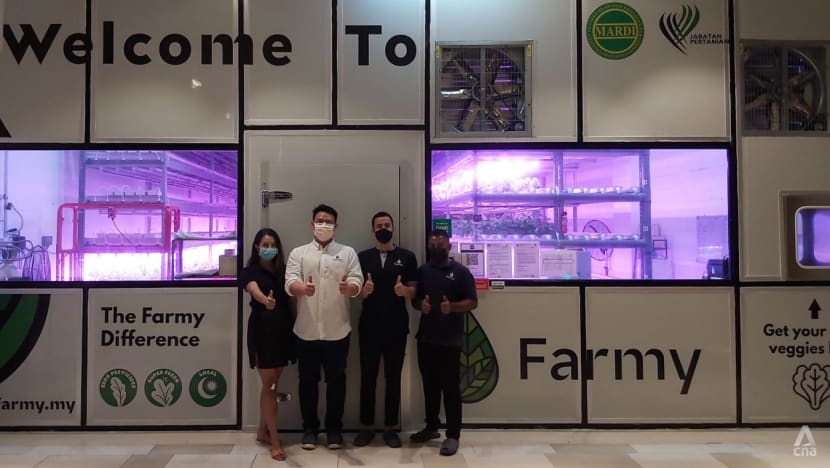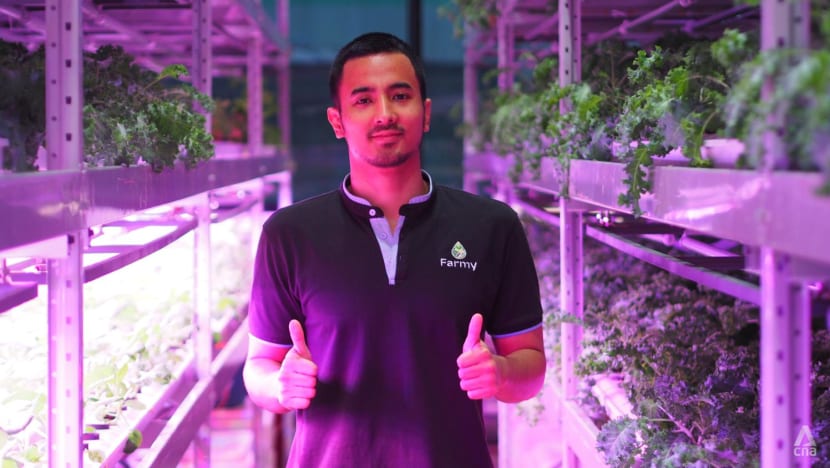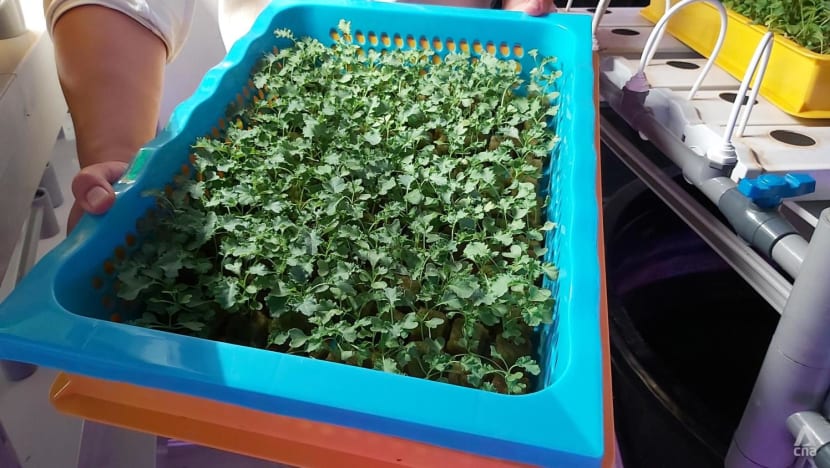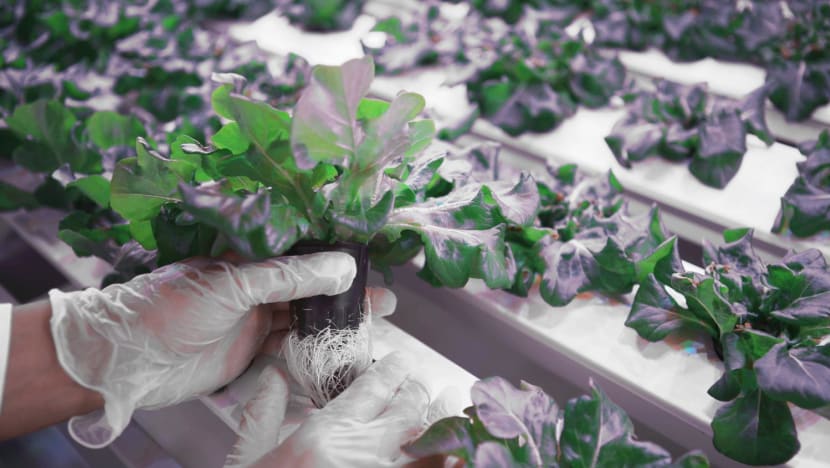Growing vegetables in a mall, this Malaysian start-up wants to shake up the traditional food supply chain

The founders and staff of Farmy urban vertical farm, located in a shopping mall in Petaling Jaya, Selangor. (Photo: CNA/Rashvinjeet S Bedi)
KUALA LUMPUR: When Shoma Tsubota tells his customers that the vegetables he sells are grown in a shopping mall, they are usually surprised.
“They say that it is the first time they have ever heard of something like it. We get that a lot. They didn’t know vegetables can be grown under the light in a mall,” he told CNA.
Located in the Encorp Strand Mall in Petaling Jaya and occupying a 1200 square feet space next to a gymnasium is Tsubota’s urban vertical farm.
Indoor vertical farms have been around in Malaysia for quite a while. However, Farmy operated by Tsubota is believed to be the first in Malaysia which is located in a mall.
“We aim to disrupt and improve the traditional food supply chain in Malaysia,” said Tsubota, who is one of the directors of Farmy.
There are five growing racks that reach up to 18 feet. Each rack is planted with seven layers of vegetables.
The produce includes kale, basil leaves, mustard leaves, wasabi salad leaves, white-stem bok choy and microgreens, among others.
At full capacity, the farm can produce 1.5 tonnes of leafy vegetables every month, which Tsubota says is equivalent to an acre of land using traditional methods.
“In the next 30 years, we will need to produce 70 per cent more food than we do today sustainably,” he said, citing estimates by the Food and Agriculture Organisation (FAO) of the United Nations back in 2010.

FRAGILITY OF THE FOOD SUPPLY CHAIN
Tsubota, 33, had started a rental business for luxury cars in 2019. But his business was hit hard by COVID-19, which saw lockdowns in Malaysia from March 2020.
“It was doing well but when there were lockdowns, there suddenly was zero income. That was when I really sat down and started thinking about agriculture,” said Tsubota, who was previously a consultant for foreign relocation service firms.
And as the pandemic took a toll, he and his two partners were cognisant of the fragility of the food supply chain, especially how Malaysia was too reliant on imported produce.
He thought there needed to be a solution where the produce is grown much closer to where the population resides.
His father and grandmother were farmers from Niigata, considered to be the rice capital of Japan and famous for the Koshihikari rice.
“When I was younger, I visited them and helped them out. That was my first experience in agriculture,” said Tsubota, whose father is Japanese and mother is Malaysian.
He said it was a tough process that involved a lot of trial and error but in May 2021, Tsubota and two of his friends finally opened up Farmy.
He said that it was important that Malaysians started thinking about whether the food they consume is good for them and the environment.
“PERFECT” GROWING ENVIRONMENT
Tsubota said that indoor farming allows them to create an almost perfect environment to grow vegetables by eliminating the risks brought about by unpredictable weather, pests and plant diseases.
“Rain or shine, we can grow vegetables 365 days a year,” he said.
He said that the whole growing process uses much less space, labour and water compared to conventional farming.
By controlling the temperature, water, light, and nutrient conditions, Tsubota said they can provide the most beneficial growing environments for the crops.
This is done by utilising hydroponics and customised LED growth lights.
The LED lights were designed specifically for vegetable growth. Green light provides chlorophyll to the vegetables, the blue light is for stem development, while red light is for the leaves.
“We select the colour combination or light recipe that is most optimal or most efficient for plant growth. Not all colours in the light spectrum are required by the plant for growth,” he said, adding that the lights were developed by the Malaysian Agricultural Research and Development Institute and manufactured in Malaysia.
The lights are left on for 12 hours per day to replicate natural sunlight.
There are two irrigation systems which are controlled automatically using sensors and the Internet of Things, ensuring that the planting is mostly automated.
The sensors measure the concentration of nutrients contained within the water that is supplied to the plants.
“If the electrical conductivity drops below the threshold of what is needed, the pumps will come on and start dosing the water with fertiliser. It’s the same with the PH readings,” he said.
He said the pumps were constantly running, providing oxygen as well as a consistent amount of water and nutrients to the crops.
Electricity usage is their main cost, especially for the lights.
It takes two weeks for the seedlings to become small plants and about another four weeks for them to grow and before they end up on the dinner table.

ENVIRONMENTALLY FRIENDLY AND PESTICIDE FREE
Tsubota claimed that their methods use up to 99 per cent less water than conventional farming methods while there is no use of pesticides, herbicides or fungicides in their crops.
The mall is located within 45 minutes of the most of Klang Valley, compared to Cameron Highlands where produce only reaches after a few days.
“A lot of people don’t realise the kind of chemicals in the vegetables. There is also a long supply chain that involves a lot of handling and contamination that takes place. We want to show people that there is a better way to eat vegetables,” said Tsubota.
According to the 2019 Malaysian Agrofood Statistics report by the Ministry of Agriculture and Food Industries, Malaysia’s self-sufficiency for vegetables was 44.4 per cent in 2019, compared to 58.4 per cent in 2014.
In Malaysia, urban farming has taken off in the past few years with shophouses, containers, or warehouses the usual chosen sites.
A question that would come to most people is why the mall of all places to run a farm?
Tsubota said they had considered shophouses and warehouses, but that they eventually chose the mall because of the infrastructure in place such as air conditioning, security, cleaners, back-up generators and water supply.
“It is located in a good location, where our market is located,” he said.
At the moment, the mall does not have a high occupancy rate. Tsubota believes that vertical farming is a potential solution for commercial developments where there is less footfall.

TEETHING PROBLEMS
Initially, Farmy’s biggest challenge was the distribution side of the business.
“There are a lot of middle-men in the traditional supply chain for agricultural products, whether it is in between the farmer and the supermarket. Trying to break through this was challenging,” Tsubota recounted.
Currently they deliver directly to about 500 homes across the Klang Valley and are working on a strategic collaboration with a leading online grocery platform.
He said they managed to build their distribution network during the pandemic, especially when people didn’t want to go out.
They did marketing on social media platforms such as Facebook and Instagram, with their customers sticking with them since.
Farmy broke even by the fourth month of operations and has already started turning profits.
The cost of full capacity would be about RM15,000 (US$3,582) monthly, with revenue able to hit RM50,000.

LOOKING AHEAD
Khazanah Research Institute (KRI) deputy research director Sarena Che Omar noted that urban farming is still growing in the country and is not expected to replace traditional forms of agriculture.
“Urban farming complements our needs and demands but it doesn’t replace agriculture. We cannot plant durian trees or padi in a mall …
“The conversation is always about salads and vegetables. When it comes to this, it does fulfill that need because we want the salad to be fresh,” she told CNA.
“Salads have a higher price per square foot than padi and therefore if you have to rent a building, you can make more profit by selling expensive lettuce and salads.”
Sarena, who specialises in policies related to food, agriculture and sustainability said that urban farming is important in fulfilling a certain demand, especially for fresh produce and something that is closer to home
She said that the growth of urban farming has created an awareness for sustainability and responsible farming.
“It was the same with organic farming. When it started to appear in Kuala Lumpur, people started talking about how their food had to be sustainable and must not have pesticides. That created consumers who are more picky, which is good,” she said.
She added that consumers in a high-income country would want food that is considered to be safer and more sustainable, as well produced taking into account labour rights.
Looking ahead, Mr Tsubota believes that Malaysia could look at exporting urban farming solutions and technology.
“We are trying to prove that this can be done locally with local technology and more people should take it up. It benefits everybody across the supply chain from the government to end users. This is a model that we want to show works,” he said.
Read this story in Bahasa Melayu here.

















